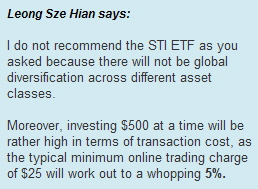| JUST ASK: ‘Should my retiree parents invest in STI ETF?’ |
| In this ocassional series titled JUST ASK, we invite readers to send in questions on stock investing, and personal finance. We will ask an expert (or experts) to provide answers. Below is a question on investing, and it is answered by Leong Sze Hian, the President of the Society of Financial Service Professionals.
We have had insurance companies give us some quotes on some savings plans but their guarantee amounts yield 1-2% at most which is extremely unproductive as it does not even cover inflation. We are keen to find out what options are available for the spare $500-$1000/month.Would the STI ETF be a good choice? What options would you recommend if we can spare the above amount monthly?
I do not recommend the STI ETF as you have asked, because there will not be global diversification across different asset classes. Moreover, investing $500 at a time will be rather high in terms of transaction cost, as the typical minimum online trading charge of $25 will work out to a whopping 5%.
Historically, the STI had an annualised return of about 3-plus % for the last 20 years or so, from 1990 to 2010, and only about 1-plus % per annum for the last 10 years. Also, betting on just one country goes against the principle of diversification – For example, Japan is still down by more than 70% after 21 years! Of course, let’s hope Singapore does not become like Japan. Therefore, however unlikely as it may be, do not belittle the lessons of history in regards to the merits of diversification.  All markets, generally, historically have an upward bias – The problem is you never know how long and how much it can stay down! : Dear reader, I suggest your parents invest in a portfolio of investment funds (about As and when they need money during their retirement, which is probably about 20-plus years, as they are now in their 60s, they can liquidate the fund(s) that have gone up the most at the time that they need the funds. To illustrate this with an example, let’s say they need $500 after 6 months, and 2 of the funds have increased by about 6%, they can sell these 2 funds first. This would mathematically translate into an The other remaining funds’ holdings that have not risen as much, or have decreased, may likely have a higher probability of giving higher returns in the future. This is using what I call the principle of “Nobody knows what or when is the best time to buy or sell”, but “The higher an investment asset has gone up a long time a lot, may have a higher probability of coming down”, and vice-versa for declining investments. 
Leong Sze Hian, President, Society of Financial Services Professionals
Leong Sze Hian says |



 Reader says: My parents are in their mid-60s and both have annuities of $500 each per month which they find are surplus, thus would like to invest the money.
Reader says: My parents are in their mid-60s and both have annuities of $500 each per month which they find are surplus, thus would like to invest the money.